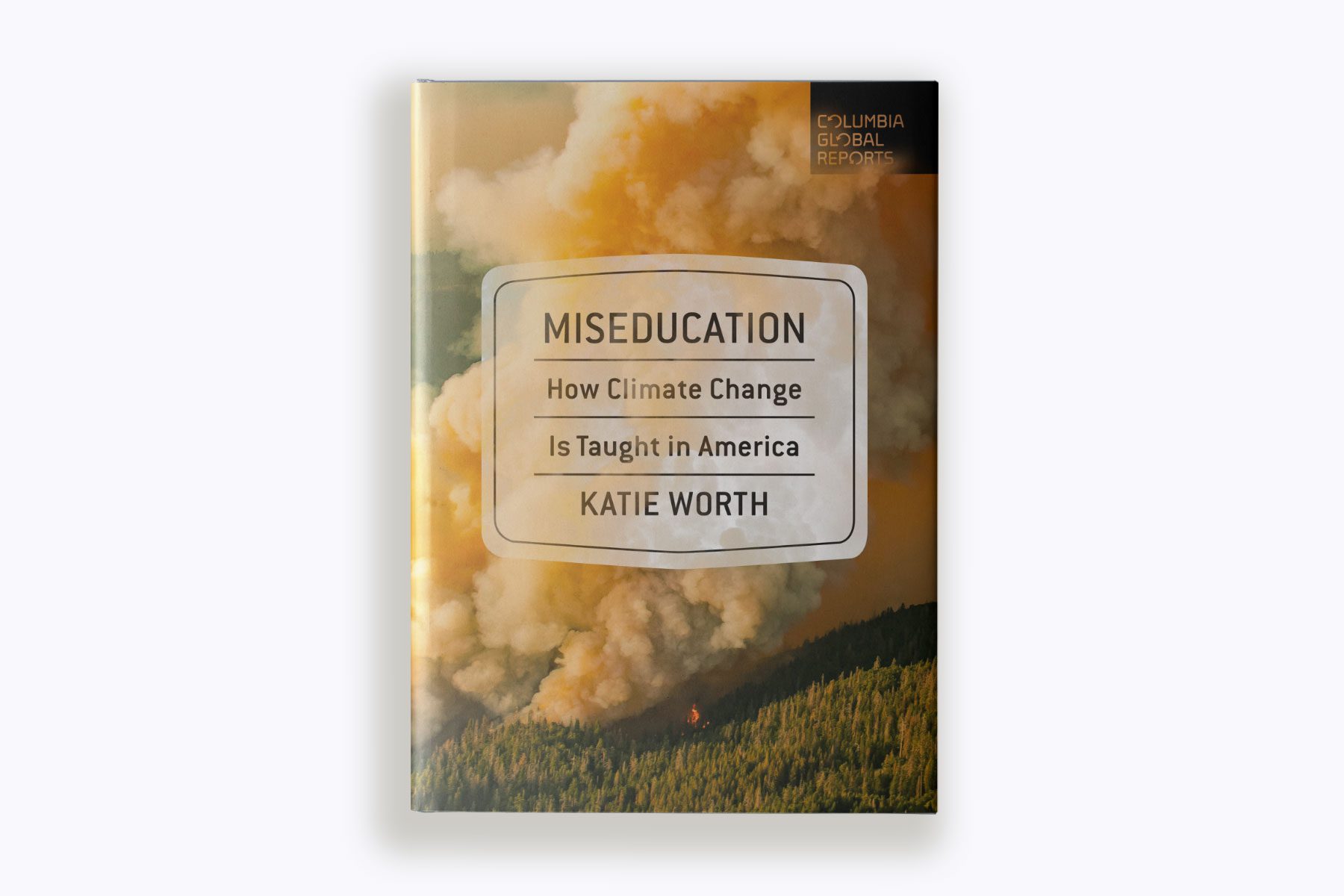What students learn about climate change can vary widely from state to state and, sometimes, even within the same school. And not all of what they learn is true. For her new book, “Miseducation: How Climate Change Is Taught in America,” Katie Worth, an award-winning former investigative journalist at Frontline PBS, reviewed dozens of science textbooks and visited communities across the country to speak to students and teachers about climate change instruction.
Worth’s book not only identifies a red-blue divide in how states approach lessons about global warming but also efforts by oil corporations, conservative lobbyists, state legislatures and others to fuel skepticism about climate science. Although most Americans believe that climate change is occurring, just one in four know that nearly all scientists agree that it is and that humans are the cause. Public ignorance about how the scientific community views global warming has given climate denialism the chance to infiltrate the classroom, “Miseducation” contends.
In an interview with The 19th, Worth addressed how climate science deniers and corporate interests are influencing science education and what teachers are doing to ensure that students learn the truth about global warming. She also discussed how young women are emerging as climate change activists and global warming intersects with gender justice and other social concerns.
This interview has been edited for length and clarity.
Nadra Nittle: What made you want to write a book about how schools teach climate change?
Katie Worth: I was assigned a story about climate change in the Marshall Islands and talked to students there in 2017. The kids there could speak really fluently about climate change, and one of the kids’ families was thinking about moving to Oklahoma. The question arose, ‘What would they learn about climate change in Oklahoma?’ I kind of got curious about that and tried to get a picture of what climate change education looks like in America. I was curious if there had been any efforts to push climate denialism in schools.
I decided to attend a conference by the Heartland Institute, a conservative think tank based in Chicago, that brings all the climate denialists together. The-then president president of the Heartland Institute told me that they were just starting to send out packets to every science teacher in America that included a book called ‘Why Scientists Disagree About Global Warming’ — which, of course, they do not — and a DVD called ‘Unstoppable Solar Cycles,’ which presents a theory that global warming is happening because of solar cycles. There’s not actually any evidence that this is true, but, sure enough, hundreds of thousands of science teachers in America received this book. Most threw it away; some of them used it. So, it just felt like there was rich territory there for reporting.
In the book, you discuss the fossil fuel industry’s influence on science education. What role is that industry playing and how does it trickle down to students in the classroom?
In some places the influence is subtle, and, in others, it’s not so subtle. The fossil fuel industry has created a lot of curricular materials that they put online for free, so if a teacher Googles, say, ‘energy lesson, fifth grade,’ they may very well find their way to a lesson plan that was developed or paid for by the fossil fuel industry and does not go into depth about climate change. In some states, the oil and gas industry association sends people out to schools to give presentations that pump up the reputation of the fossil fuel industry. In Oklahoma, they produce kids’ books like ‘Petro Pete’s Big Bad Dream’ about a little boy who wakes up in a world where there are no petroleum products, and it’s a total nightmare. That book is in every elementary school in Oklahoma. And the fossil fuel industry’s influence on how standards are adopted in some places was very visible in Texas this last year. The oil industry pushed hard to water down what was in the standards about climate change.
One point the book raises that readers may not know is that science instruction varies from one state to another. The next generation science standards provide a framework for K-12 science education. But many states have not adopted them, and those that have differ in their approach to these standards.
The next generation science standards was an effort of educators from all over the country to think about what the research says about how to teach kids about science. What’s the best pedagogy? How can we make a better set of standards or best practices? And then those teachers went back to their own states and tried to get their states to adopt the standards or a version of them.
How are teachers circumventing climate change denialism?
There’s a ton of teachers who really care about this issue and want their students to be engaged, so they teach climate change. But there’s lots of teachers who avoid the issue or they teach it as a debate, asking whether or not climate change is happening or whether or not it’s being caused by humans. They’re basically asking students to debate something that scientists don’t debate, and that’s a big problem. A lot of teachers themselves didn’t learn about climate change in school. They don’t have a lot of support or professional development resources to learn about it. They know that there’s going to be pushback if they teach about climate change, so they kind of just sidestep it. But there are some efforts to make sure teachers do have lessons on climate change. In Washington, they’re working on giving every science teacher in the state a seminar on how to incorporate climate change into their lessons. Having a concerted program like ClimeTime to get them to think through how to bring up the topic in their own classrooms is really helpful and necessary.
Early on in the book, you discuss how a history teacher at a school in Chico, California, was showing students climate change hoax videos, making it difficult for the science teacher nearby to teach students about global warming. So, within the same school in a liberal state like California, students were getting very different messages about climate change. What are your thoughts about that?
There’s a mix of people of all ideologies in each state. So, that means even in the reddest states, there’s teachers who are intrepidly teaching that subject no matter what the standards say or what’s in their official curriculum, just because they think it’s important and that students deserve to know. Then, in even the most liberal communities, there are people who have really absorbed this idea that the science is unsure and that it’s all a hoax, and they pass that onto their students in some way, either directly, the way that that history teacher was doing, or kind of more indirectly, like teaching it as a debate.
Your book argues that climate change instruction is important for students not only because they need to understand science but also because they’re already experiencing the effects of global warming.
That’s one of the arguments that educators make about why we should talk to students about this issue. It’s arguably the most important scientific issue of our century and definitely one of the most socially important ones, and it’s already impacting the world. It’s not like some hypothetical, futuristic problem; it’s already happening and these kids are already living through it. At the end of the book, I talk about being in Chico and observing a class of middle school students whose school had been closed because it was in a wildfire, and they were displaced into a hardware store because that was the only real estate available for that school. Those kids in that school could arguably be called climate refugees, but lots of them had never even heard of climate change, or if they had heard anything about it, they’d heard that it was a hoax, even as their lives had already been transformed by it. Students have a right to understand the world that they’re born into, and this is a central theme of that world. This knowledge also allows them to participate in the solutions, to kind of roll up their sleeves and get to work with the rest of us.
Do you see similarities between efforts to promote climate change denialism in schools and the movement to ban critical race theory in schools, which has garnered much more attention?
I think CRT, critical race theory, has gotten a ton of attention in the last year. Schools have become a focus of the culture war. Climate change has not been the central focus; race and sexuality have been. But from my reporting, I know that there’s a ton of friction over what kids learn about climate change. I hardly talked to a single teacher who didn’t have some story about getting pushback from parents, students, other teachers or their own administration. It’s become this political issue, so I think climate change is part of the same culture war as CRT. Denialists are trying to control what kids learn and don’t learn, and that’s happening with the CRT debate, too.
‘Miseducation’ mentions Greta Thunberg’s work to raise awareness about climate change. Do you think the activism of Greta and other young women, like Vanessa Nakate, will influence students in the U.S. to take an interest in climate change, even if they’re not learning about it in school?
School isn’t the only place kids learn. They learn from the media. They learn from their family. They learn from social media. So, even if they’re not encountering information about climate change in their school, they are encountering information about it elsewhere, and student activists like Greta and many others are a powerful force. It can actually work backwards, where students are engaged in this issue, and then they go talk to their teachers, and they’re like, ‘Hey, I want to know about this,’ or, ‘Oh, we’re on a weather unit. Tell me about climate change.’ And then the teachers who want to engage their class and want to be teaching things that the class is interested in start incorporating that into their lessons. There’s also evidence that there’s an intergenerational effect. There’s a really interesting study done where they looked at what happened when they educated kids in this really conservative community and how that affected their parents, and what they found was when they educate the kids about climate change, their parents became more concerned about climate change, because the kids were coming home and talking to their parents, and then the parents were like, ‘Oh, yeah, I should learn about that.’ That effect was especially powerful with little girls, and especially effective on fathers.
Increasingly, climate change has been framed as a racial justice issue, a gender justice justice issue, an economic justice issue. Might framing climate change in this way make students more concerned about it?
Absolutely. This issue layers on to all of the other systems of oppression in our world, and there’s plenty of evidence that shows that women will suffer more because of climate change, than men globally, and that people of color and poor people will suffer more than privileged folks globally. It’s not happening in a vacuum. It’s happening within the context of a heteropatriarchal, racist world, and so for people who are interested in racial justice, social justice or gender justice, climate change absolutely fits into that picture.







